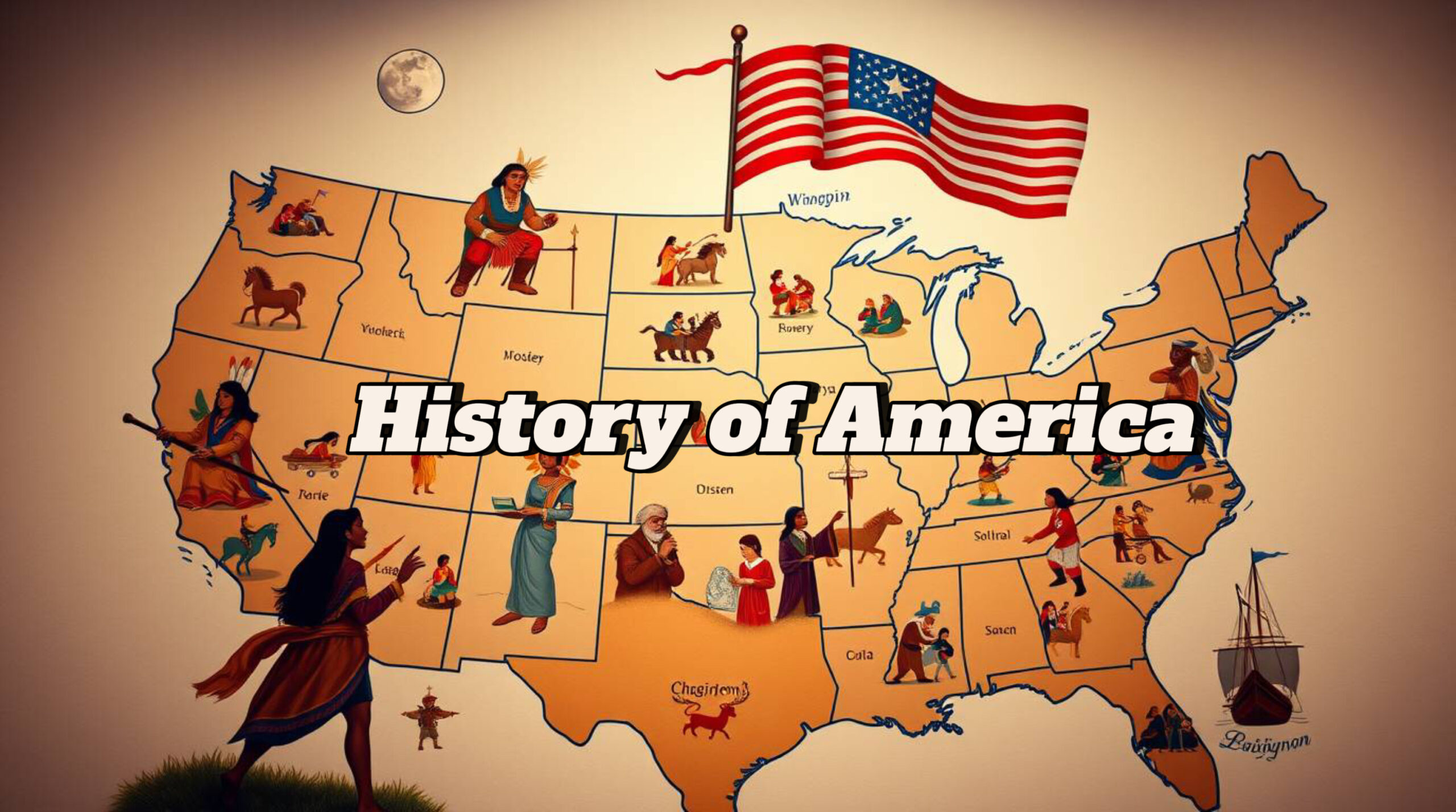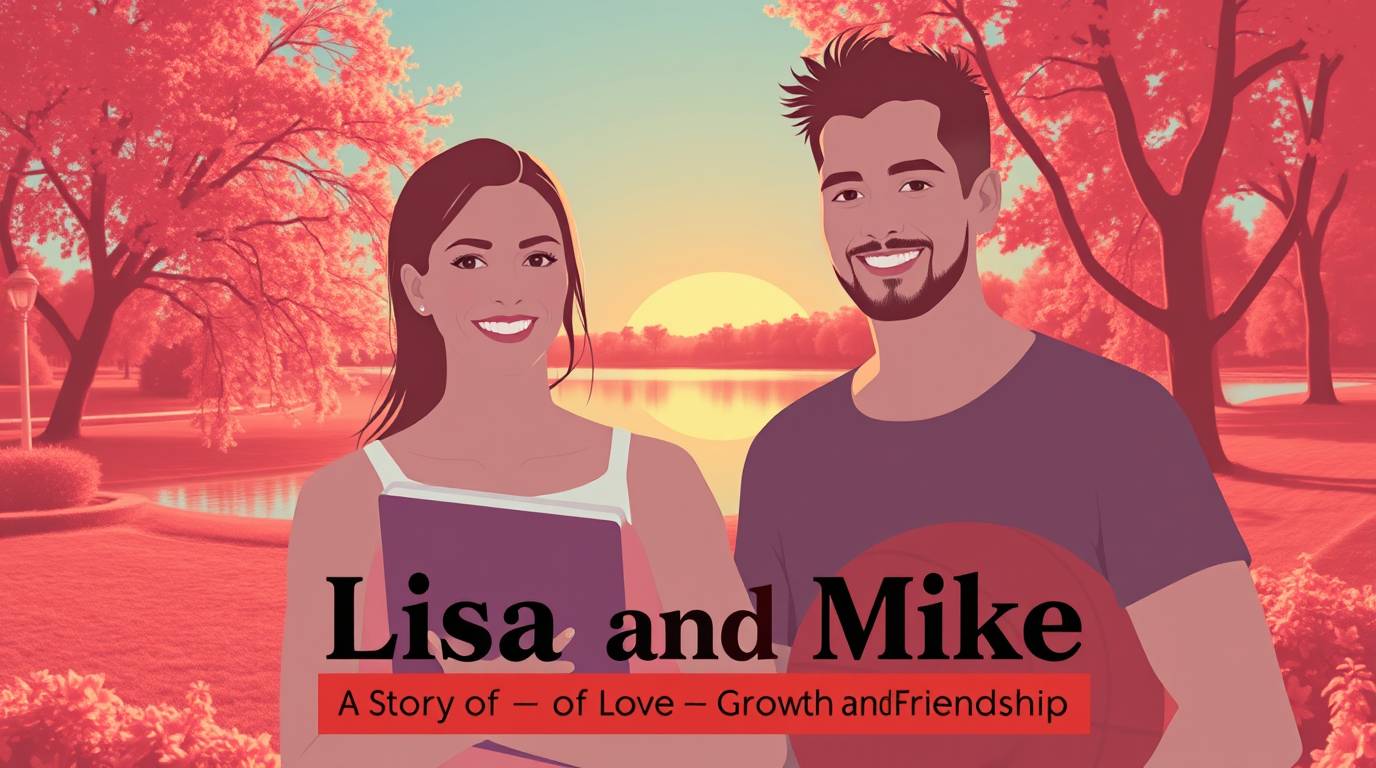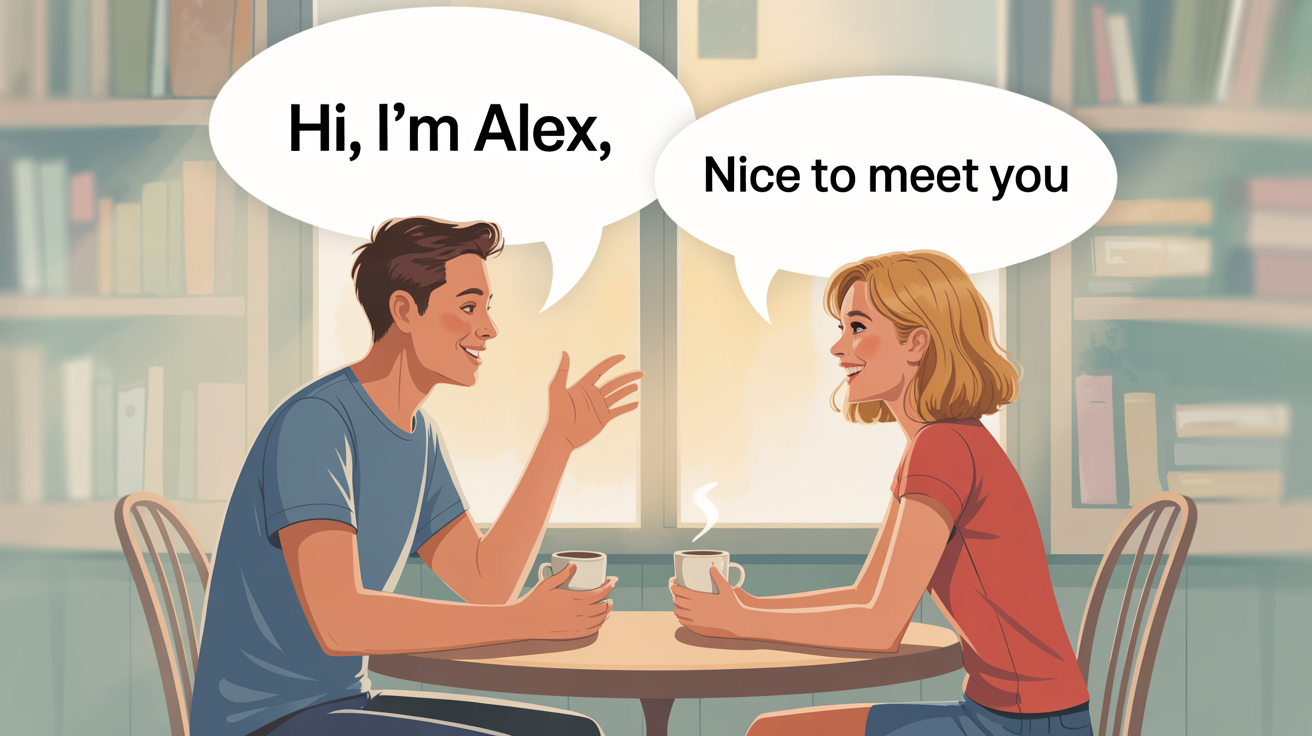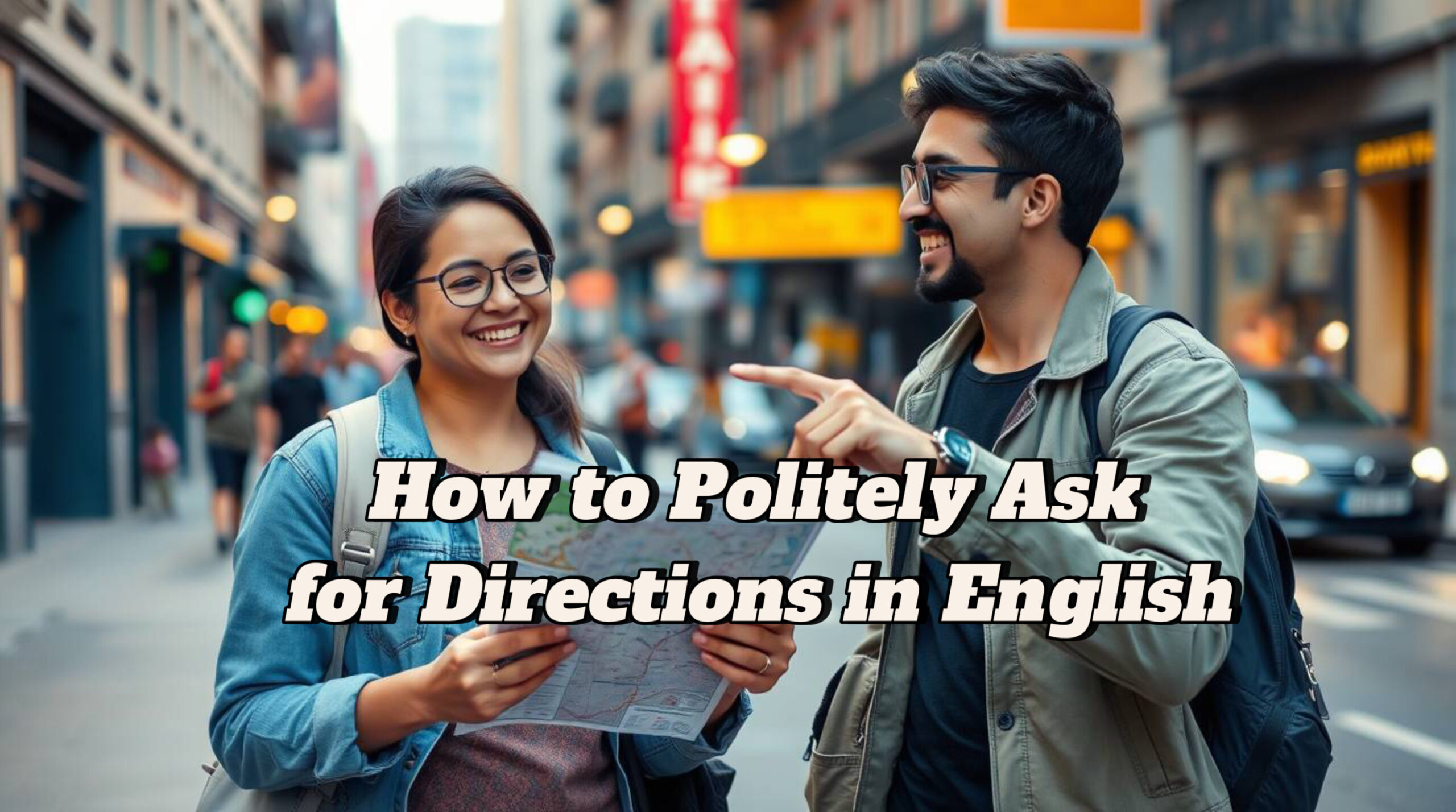Introduction
Exploring the history of the United States is one of the most fascinating journeys you can take, and this series is your perfect guide for that adventure! Just like visiting a new city, diving into history allows you to discover incredible stories, unforgettable moments, and key people who shaped the world. The USA, known for its diversity and innovation, has a rich and vibrant history, filled with amazing events—from the first Native American tribes to the moon landing.
In this series, we’ll guide you step-by-step through this incredible story. Whether you’re learning about the Founding Fathers or understanding how technology changed the nation, each chapter will help you uncover the pieces that make up the United States today. So, grab a notebook, get comfortable, and let’s begin this exciting journey through time!
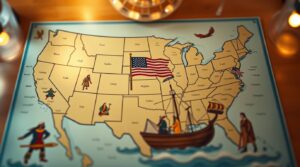
Chapter 1: Welcome to the Story
In this series, we will learn about the history of the United States. Don’t worry—we will use easy words and short sentences so you can understand everything.
History is like a big story. It tells us about people, places, and events from the past. Learning history helps us understand the world today.
The United States is a very big country with 50 states. It has many different people, languages, and traditions. But how did it all begin? That’s what we will find out together!
In the next 20 chapters, we will talk about:
– The first people in America.
– How the USA became a country.
– Important people like George Washington and Martin Luther King Jr.
– Big events like wars, inventions, and trips to the moon.
By the end of this series, you will know more about the USA—and your English will get better too!
Key Vocabulary
History: Stories about the past.
Country: A large area of land with its own government.
States: Parts of a country. The USA has 50 states.
Traditions: Customs or ways of doing things that are passed down.
Events: Important things that happen.
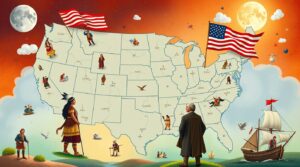
Chapter 2: The First People.
A long time ago, before cars, phones, or cities, the first people in America were the Native Americans. They lived in big groups called tribes. Each tribe had its own language, clothes, and way of life.
The Native Americans lived close to nature. They hunted animals like deer and buffalo. They fished in rivers and lakes. They also grew food like corn, beans, and squash. These foods were very important for their meals.
They built homes using what they found around them. Some tribes lived in teepees small houses made from wood and animal skins. Others lived in longhouses, which were bigger and made from wood and bark.
The Native Americans loved stories, music, and art. They painted pictures on rocks and made jewelry from feathers and beads. They also told stories about the stars, animals, and the Earth.
Life was simple but happy. The Native Americans took care of the land and animals because they believed everything was connected.
Key Vocabulary
Native Americans: The first people who lived in America.
Tribes: Big groups of people with the same language and traditions.
Hunting: Catching animals for food.
Fishing: Catching fish from rivers or lakes.
Corn: A yellow plant used for food.
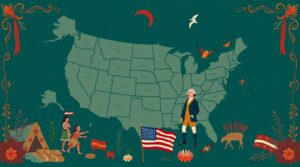
Chapter 3: Christopher Columbus
A long time ago, in 1492, a man named Christopher Columbus went on a big trip. He was looking for a new way to travel to Asia. But instead, he found something new—a land we now call America.
Columbus sailed across the ocean with three ships: the Niña, the Pinta, and the Santa Maria. After many weeks at sea, he saw land. He thought he was in Asia, but he was wrong. He had reached the Bahamas, a group of islands in the Caribbean.
When Columbus arrived, he met the Native Americans. He called them “Indians” because he thought he was in India. The Native Americans were kind and helped Columbus and his crew.
Columbus made four trips to the New World, but he never knew he had found a new continent. His voyages opened the door for other explorers to come to America.
Key Vocabulary
Explorer: A person who travels to new places to learn about them.
Ocean: A very large area of salt water.
Ships: Big boats used for traveling on water.
Bahamas: A group of islands in the Caribbean Sea.
Voyages: Long trips, usually by ship.
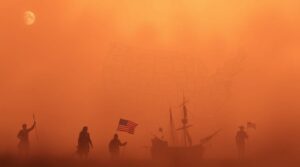
Chapter 4: The First Settlers.
A long time ago, in 1620, a group of people called the Pilgrims left England. They wanted to find a new home where they could practice their religion freely. They sailed across the ocean on a ship called the Mayflower.
After a long and difficult trip, the Pilgrims arrived in America. They landed at a place called Plymouth, in what is now Massachusetts. The weather was cold, and they had no homes or food. Life was very hard for them.
The Native Americans helped the Pilgrims. They taught them how to grow food like corn and how to hunt and fish. With the Native Americans’ help, the Pilgrims survived their first winter.
In the fall, the Pilgrims had a big meal to say thank you. They invited the Native Americans to join them. This meal became the first Thanksgiving. It was a time to give thanks for food, friendship, and life.
The Pilgrims stayed in America and built a new life. More settlers came after them, and slowly, more towns and villages were built.
Key Vocabulary
Pilgrims: People who left England to find religious freedom.
Mayflower: The ship the Pilgrims used to travel to America.
Plymouth: The place where the Pilgrims landed in America.
Thanksgiving: A special meal to give thanks for good things.
Settlers: People who move to a new place to live.
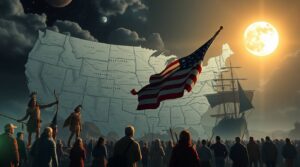
Chapter 5: The American Revolution.
A long time ago, in the 1700s, America was not a free country. It was part of the British Empire, and people in America were called colonists. They had to follow rules made by the king of England.
But the colonists were not happy. They had to pay many taxes, or money, to Britain. They felt this was unfair because they had no say in the rules. They said, “No taxation without representation!”
In 1775, the colonists decided to fight for freedom. This fight was called the American Revolution. It was a war between the colonists and Britain.
The colonists had help from other countries like France. They also had strong leaders like George Washington, who led their army. After many battles, the colonists won the war in 1783.
In 1776, during the war, the colonists wrote an important paper called the Declaration of Independence. It said that America was now a free country. People celebrated because they were no longer under British rule.
The American Revolution was very important. It showed that people could fight for freedom and make their own choices.
Key Vocabulary
Colonists: People who lived in America but were ruled by Britain.
Taxes: Money people have to pay to the government.
Revolution: A big change, often through fighting.
Declaration of Independence: A paper that said America was free.
Freedom: The ability to make your own choices.
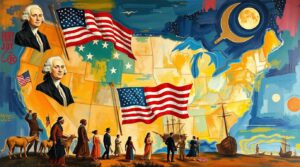
Chapter 6: George Washington
After the American Revolution, America was a new country. It needed a leader to help it grow and stay strong. That leader was **George Washington**.
George Washington was born in 1732 in Virginia. He grew up on a farm and later became a soldier. During the American Revolution, he was the leader of the colonial army. He worked hard to keep his soldiers brave and united, even when times were tough.
When the war ended, people chose George Washington to be the first **president** of the United States. He served as president from 1789 to 1797. He helped create rules for the new government and made sure everyone worked together.
George Washington was a very honest man. People called him “the father of his country” because he did so much for America. He showed that a leader should care about the people and do what is right.
Today, you can see George Washington’s face on the one-dollar bill and on Mount Rushmore, a big mountain with carvings of famous presidents.
Key Vocabulary
President: The leader of a country.
Army: A group of soldiers who fight for their country.
Government: The group of people who make rules for a country.
Honest: Always telling the truth and doing what is right.
Mount Rushmore: A mountain with carvings of four famous U.S. presidents.
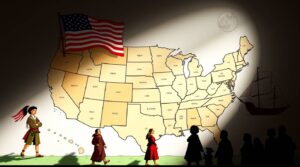
Chapter 7: The 50 States
After the American Revolution, the United States was small. It had only 13 states along the East Coast. These were called the Thirteen Colonies. But over time, more land was added, and new states were created.
In 1787, the United States wrote a special paper called the Constitution. This paper explained the rules for the country. One rule said that new states could join the United States.
As the years passed, people moved west to explore new lands. They built towns, farms, and cities. Slowly, new states were added to the country. For example:
– In 1867, Alaska became part of the U.S.
– In 1959, Hawaii became the 50th state.
Today, the United States has 50 states. Each state is different. Some are big, like Texas. Others are small, like Rhode Island. Each state has its own flag, bird, and flower.
Even though the states are different, they all work together as one country. People in the U.S. say, “United we stand, divided we fall.” This means that when everyone works together, the country is strong.
Key Vocabulary
States: Parts of a country. The U.S. has 50 states.
Thirteen Colonies: The first 13 states in America.
Constitution: A paper with rules for the country.
Alaska: The largest state in the U.S.
Hawaii: The 50th state, located in the Pacific Ocean.
Chapter 8: The Civil War
A long time ago, in the 1800s, the United States was not united. There were big problems between the northern states and the southern states. These problems led to a war called the Civil War.
The main problem was about slavery. In the South, many people had slaves who worked on farms and in homes. But in the North, many people thought slavery was wrong. They wanted it to end.
In 1861, the southern states decided to leave the United States. They made their own country called the Confederacy. The northern states stayed in the United States, also called the Union.
The Civil War started when the North and South began fighting. It was a very sad time. Many people died, and families were separated.
The leader of the Union was President Abraham Lincoln. He wanted to bring the country back together and end slavery. After four years of fighting, the North won the war in 1865.
After the war, slavery was ended everywhere in the U.S. This was a big step toward making America a fairer country.
Key Vocabulary
Civil War: A war between people in the same country.
Slavery: When one person owns another person and makes them work.
Confederacy: The group of southern states during the Civil War.
Union: The group of northern states during the Civil War.
Abraham Lincoln: The president who helped end slavery.
Chapter 9: Abraham Lincoln
Abraham Lincoln was born in 1809 in a small log cabin in Kentucky. He grew up poor but worked hard to become a lawyer and later a politician. In 1860, he was elected as the 16th president of the United States.
Lincoln became president at a very difficult time. The country was divided over the issue of slavery, and the Civil War started soon after he took office. Lincoln wanted to keep the United States together and end slavery.
One of Lincoln’s most famous actions was the Emancipation Proclamation. This was a paper he wrote in 1863 that said all slaves in the southern states were free. It was a big step toward ending slavery forever.
Lincoln also gave a famous speech called the Gettysburg Address. In this short speech, he talked about equality and the importance of keeping the country united.
Sadly, Lincoln did not live to see the full results of his work. In 1865, just after the Civil War ended, he was killed by a man who did not agree with him. People remember Lincoln as a hero because he fought for freedom and unity.
Today, you can see Lincoln’s face on the penny (the smallest U.S. coin) and on the five-dollar bill. His statue is also in the Lincoln Memorial in Washington, D.C.
Key Vocabulary
– Abraham Lincoln: The 16th president of the United States.
– Slavery: When one person owns another person and makes them work.
– Emancipation Proclamation: A paper that said slaves were free.
– Gettysburg Address: A famous speech by Lincoln about equality.
– Lincoln Memorial: A big statue of Lincoln in Washington, D.C.
Chapter 10: The Industrial Revolution
A long time ago, most people lived on farms and made things by hand. But then, something amazing happened—the Industrial Revolution. This was a time when machines began to do work that people used to do. It changed how people lived and worked.
During the Industrial Revolution, many new inventions were made. For example:
– The steam engine helped trains and boats move faster.
– The cotton gin made it easier to clean cotton.
– The telegraph allowed people to send messages quickly over long distances.
Factories were built in cities, and many people moved from farms to work in these factories. Cities grew bigger and busier because of all the new jobs.
The Industrial Revolution also brought new ways to travel. Trains and railroads connected cities across the country. People could now travel farther and faster than ever before.
Life became easier in many ways, but it was also hard for some people. Factory workers often worked long hours for little money. Children sometimes had to work in factories too.
Even though life was not perfect, the Industrial Revolution helped America grow into a strong and modern country.
Key Vocabulary
Industrial Revolution: A time when machines changed how people worked and lived.
Steam engine: A machine that made trains and boats move.
Cotton gin: A machine that cleaned cotton quickly.
Telegraph: A machine that sent messages over long distances.
Factories: Big buildings where things are made using machines.
This chapter explains the Industrial Revolution in a simple, engaging way, focusing on key inventions and their impact on daily life. It also touches on both the positive and negative effects of this period, making it accessible for A1 learners.
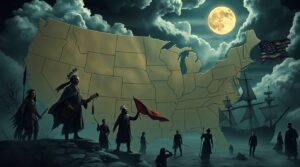
Chapter 11: World War I
A long time ago, in 1914, a big war started in Europe. This war was called World War I. Many countries were fighting, and it was very dangerous. At first, the United States did not join the war. But later, they decided to help.
The war began because of a problem between countries. One day, a man named Archduke Franz Ferdinand, who was from Austria-Hungary, was killed. This made many countries angry, and they started fighting.
At first, the U.S. stayed out of the war. But in 1917, Germany did something that made the U.S. very upset. Germany sank American ships, so the U.S. decided to join the fight.
The U.S. helped the Allies, which were countries like Britain, France, and Russia. Together, they fought against the Central Powers, which included Germany and Austria-Hungary.
Many soldiers went to Europe to fight. The war was very hard, and many people died. Finally, in 1918, the war ended. The U.S. and its friends won, and peace was made.
After the war, President Woodrow Wilson wanted to make sure there would be no more big wars. He helped create the League of Nations, a group of countries that worked together to keep peace.
Key Vocabulary
World War I: A big war that happened from 1914 to 1918.
Archduke Franz Ferdinand: A leader whose death started the war.
Allies: Countries that fought together, including the U.S., Britain, and France.
Central Powers: Countries that fought against the Allies, like Germany.
League of Nations: A group created to keep peace after the war.
Chapter 12: The Great Depression
A long time ago, in 1929, something bad happened in America. It was called the Great Depression. This was a time when the economy—how people buy and sell things—stopped working well. Many people lost their jobs, homes, and money.
The Great Depression started with something called the Stock Market Crash. The stock market is a place where people buy and sell parts of companies. In 1929, the stock market crashed, which means that many people lost all their money.
Because of the crash, businesses closed, and many people could not find work. Farmers also had problems. There was a big drought—a time with no rain—and their crops died. This made food very expensive.
Life was very hard during the Great Depression. Many families did not have enough food or clothes. Some people lived in small houses made of wood and metal, called shantytowns. Others traveled around the country looking for work.
But even in hard times, people tried to help each other. Families shared what little they had. People listened to the radio for fun because it was cheap. And some went to the movies to forget their troubles for a while.
Finally, in 1933, a new president named Franklin D. Roosevelt came to help. He made a plan called the New Deal. The New Deal gave people jobs and helped them get back on their feet. Slowly, life started to get better.
Key Vocabulary
Great Depression: A time in the 1930s when many people had no jobs or money.
Stock Market Crash: When the stock market failed, and people lost their money.
Drought: A long time with no rain.
Shantytowns: Small, poor houses made of wood and metal.
New Deal: A plan by President Roosevelt to help people during the Great Depression.
This chapter explains the Great Depression in a simple, engaging way, focusing on the challenges people faced and how they worked together to survive. It also highlights President Roosevelt’s efforts to help the country recover, making it accessible for A1 learners.
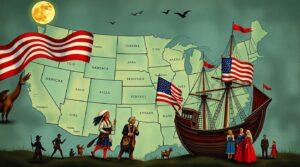
Chapter 13: World War II
A long time ago, in 1939, a man named Adolf Hitler started a war in Europe. He wanted to control many countries, and soon other nations had to fight back. This war became known as World War II.
At first, the United States did not join the war. But on December 7, 1941, something terrible happened. Japan attacked a U.S. naval base called Pearl Harbor in Hawaii. Many American ships and soldiers were hurt or destroyed. After this attack, the U.S. decided to join the war.
The U.S. helped the Allies, which included countries like Britain, France, and the Soviet Union. They fought against the Axis Powers, which were led by Germany, Japan, and Italy.
During the war, many American soldiers were sent to Europe and the Pacific to fight. Meanwhile, people back home worked hard to support the war effort.” Women worked in factories, making planes, tanks, and weapons. People also grew food in their gardens, called victory gardens, to help with food shortages.
Finally, in 1945, the war ended. The Allies won, and peace was made. The U.S. helped rebuild Europe and Japan after the war.
One important moment during the war was when President Franklin D. Roosevelt gave a famous speech called the Four Freedoms. He talked about freedom of speech, freedom of religion, freedom from want, and freedom from fear. These ideas helped inspire people to keep fighting for a better world.
Key Vocabulary
– World War II: A big war that happened from 1939 to 1945.
– Adolf Hitler: A leader who started the war in Europe.
– Pearl Harbor: A U.S. naval base attacked by Japan in 1941.
– Allies: Countries that fought together, including the U.S., Britain, and the Soviet Union.
– Victory Gardens: Small gardens where people grew food during the war.
This chapter introduces World War II in a simple, factual way, focusing on why the U.S. joined the war, how people supported the effort at home, and the eventual victory. It also highlights key terms and concepts, making it accessible for A1 learners.
Chapter 14: The Civil Rights Movement
A long time ago, in the 1950s and 1960s, many African Americans in the United States did not have the same rights as white people. They could not go to the same schools, eat in the same restaurants, or even sit where they wanted on buses. This was called segregation, and it was very unfair.
Many people decided to fight against segregation. They wanted everyone to be treated equally, no matter their skin color. This fight became known as the Civil Rights Movement.
One of the most important leaders of the Civil Rights Movement was Martin Luther King Jr. He was a pastor and a speaker who believed in peace. He said that people should protest without using violence.
In 1963, Martin Luther King Jr. gave a famous speech called “I Have a Dream.” In this speech, he talked about a future where all people would be treated equally. He said, “I have a dream that my four little children will one day live in a nation where they will not be judged by the color of their skin but by the content of their character.”
Many people joined marches and protests to show they wanted change. One famous event was the March on Washington, where thousands of people came together to listen to Martin Luther King Jr. speak.
Finally, in 1964, a new law called the Civil Rights Act was passed. This law said that segregation was illegal, and everyone had to be treated equally. It was a big step toward making America fairer.
Even though things got better, the fight for equality is still going on today. People continue to work for fairness and respect for everyone.
Key Vocabulary
Civil Rights Movement: A time when people fought for equal rights for everyone.
Segregation: When people are separated based on their skin color.
Martin Luther King Jr. A leader who fought for equality and peace.
Civil Rights Act: A law that made segregation illegal and helped bring equality.
This chapter explains the Civil Rights Movement in a simple, engaging way, focusing on key figures like Martin Luther King Jr. and important events like the March on Washington. It also highlights the ongoing struggle for equality, making it relatable for A1 learners.
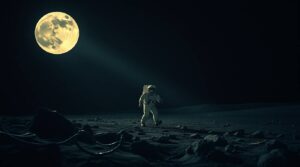
Chapter 15: The First Man on the Moon
A long time ago, in 1969, something amazing happened. A man named Neil Armstrong became the first person to walk on the moon. This was part of a big project called Apollo 11, led by NASA, the U.S. space agency.
The journey to the moon started with a big dream. President John F. Kennedy said in 1961 that America would send a man to the moon before the end of the decade. Many people worked hard to make this dream come true.
On July 16, 1969, three astronauts—Neil Armstrong, Buzz Aldrin, and Michael Collins—climbed into a spaceship called the Saturn V. They launched from Florida and traveled through space for four days.
Finally, on July 20, 1969, Neil Armstrong stepped out of the spaceship onto the moon. He said, “That’s one small step for man, one giant leap for mankind.” These words mean that while his step was small, it was a huge moment for all people.
Buzz Aldrin also walked on the moon, but Michael Collins stayed in the spaceship to make sure everything worked well. The astronauts collected rocks and took pictures to bring back to Earth.
After their trip, the astronauts returned safely to Earth. People around the world watched on TV and celebrated this big achievement. It showed that humans could do amazing things if they worked together.
Key Vocabulary
– Neil Armstrong: The first man to walk on the moon.
– Apollo 11: The name of the mission that sent men to the moon.
– NASA: The U.S. space agency that works on space exploration.
– Saturn V: The rocket that carried the astronauts to the moon.
– Mankind: All people, everywhere.
Chapter 16: Technology Changes
A long time ago, people did not have computers, phones, or the internet. But over time, new inventions made life easier and faster. These changes are called technology changes, and they happened in many ways.
One big change was the invention of the computer. The first computers were very big and expensive. They could only do simple math problems. But over time, computers became smaller, faster, and cheaper. Today, almost everyone has a computer at home or in their pocket as a smartphone.
Another important invention was the internet. The internet is like a big library that connects people all over the world. It lets us talk to friends, watch videos, and find information quickly. The internet started in the 1960s, but it became popular in the 1990s. Now, we use it every day for school, work, and fun.
Technology also changed how we communicate. Long ago, people wrote letters and waited weeks for a reply. Then came the telephone, which let people talk instantly. Later, cell phones and texting made communication even faster. Now, with apps like email and video calls, we can talk to anyone, anywhere, anytime.
Other inventions, like robots and smart homes, are changing the way we work and live. Robots can do hard or boring jobs, like building cars or cleaning floors. Smart homes let us control lights, music, and even locks with our phones.
Technology makes life easier, but it also brings challenges. Some people worry about spending too much time on phones or computers. Others worry about privacy and safety online. But overall, technology helps us learn, work, and connect in amazing ways.
Key Vocabulary
Technology: New tools and machines that help people live better.
Computer: A machine that can do math, store information, and more.
Internet: A system that connects computers around the world.
Telephone: A device that lets people talk to each other far away.
Smart Homes: Houses where you can control things like lights with your phone.
Remaining part
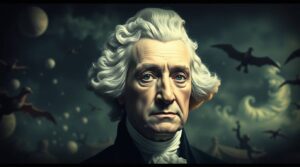
Chapter 17: Famous Americans
America has been home to many amazing people who changed the country—and sometimes even the world. Let’s meet a few of them!
- George Washington:
George Washington was the first president of the United States. He helped America become a free country during the American Revolution. People call him “the father of his country” because he did so much for America.
- Abraham Lincoln:
Abraham Lincoln was the 16th president of the United States. He fought to end slavery and keep the country united during the Civil War. His leadership saved America from breaking apart.
- Martin Luther King Jr.:
Martin Luther King Jr. was a leader in the Civil Rights Movement. He worked hard to make sure everyone was treated equally, no matter their skin color. His famous speech, “I Have a Dream,” inspired millions of people.
- Thomas Edison:
Thomas Edison was an inventor who created many things we still use today. He invented the light bulb, which gives us light at night. He also worked on the phonograph, which plays music.
- Rosa Parks:
Rosa Parks was a brave woman who stood up against unfair laws. In 1955, she refused to give up her seat on a bus to a white person. Her action started a big movement for equal rights.
- Neil Armstrong:
Neil Armstrong was the first man to walk on the moon. His trip to space showed that humans can do amazing things when they work together.
These are just a few of the many famous Americans who have made history. Each of them worked hard to make life better for others.
Key Vocabulary
– George Washington: The first president of the United States.
– Abraham Lincoln: A president who ended slavery and kept the U.S. united.
– Martin Luther King Jr.: A leader who fought for equal rights for all people.
– Thomas Edison: An inventor who made the light bulb and phonograph.
– Rosa Parks: A woman who stood up for equal rights by refusing to give up her seat.
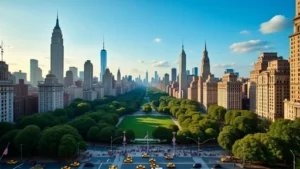
Chapter 18: The USA Today
The United States is a big and diverse country with people from all over the world. It has 50 states, each with its own culture, food, and traditions. Let’s explore some parts of life in the USA today!
- Cities and Landscapes:
The USA has many big cities, like New York, Los Angeles, and Chicago. These cities are full of tall buildings, busy streets, and lots of people. But the USA also has beautiful natural places, like the Grand Canyon, Yellowstone National Park, and beaches in Florida and California.
- Food:
American food is very popular around the world. People love things like hamburgers, hot dogs, and pizza. But because the USA is so diverse, you can also find food from other countries, like Mexican tacos, Chinese noodles, and Italian pasta.
- Work and School:
Many Americans work in offices, schools, hospitals, or factories. Some people also work online from home. Kids go to school from Monday to Friday. They study math, science, history, and English, just like you!
- Holidays:
Americans celebrate many holidays. One of the biggest is Thanksgiving, when families eat turkey and give thanks for good things. Another big holiday is Independence Day on July 4th, when people watch fireworks and have barbecues.
- Technology:
Technology is a big part of life in the USA today. Most people use smartphones, computers, and the internet every day. Social media apps like Instagram and TikTok are very popular, especially with young people.
- Diversity:
The USA is home to people from all over the world. This makes the country very diverse. You can hear many languages, see different clothes, and taste foods from different cultures. This diversity makes America special.
Even though life in the USA is not perfect, it is a place where people can dream big and work hard to achieve their goals.
Key Vocabulary
Diverse: Having many different kinds of people or things.
Grand Canyon: A big, beautiful canyon in Arizona.
Thanksgiving: A holiday when families eat turkey and give thanks.
Independence Day: A holiday on July 4th to celebrate America’s freedom.
– Technology: Tools and machines that make life easier.
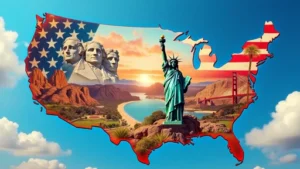
Chapter 19: Fun Facts About the USA
- The Statue of Liberty:
The Statue of Liberty is a famous symbol of America. It was a gift from France in 1886. The statue stands in New York Harbor and welcomes people coming to America. Did you know that the statue is over 305 feet (93 meters) tall? That’s as tall as a 22-story building!
- The White House:
The White House is where the president of the United States lives and works. It has been the home of every U.S. president since John Adams in 1800. The White House has 132 rooms, including a movie theater and a bowling alley!
- The Longest River:
The Mississippi River is one of the longest rivers in the world. It stretches over 2,300 miles (3,700 kilometers) across the country. People use it for travel, fishing, and fun activities like boating.
- Fast Food:
Did you know that many popular fast-food chains started in the USA? McDonald’s, Burger King, and KFC are all American companies. Americans love fast food so much that they spend billions of dollars on it every year!
- The World’s Biggest Economy:
The USA has the largest economy in the world. This means it makes and sells more things than any other country. Many big companies, like Apple, Google, YouTube and Amazon, come from the USA.
- Hollywood:
Hollywood in California is known as the movie capital of the world. Many famous movies and TV shows are made there. Every year, actors and filmmakers go to the Academy Awards, also called the Oscars, to celebrate the best movies.
- The Bald Eagle:
The bald eagle is the national bird of the USA. It is a symbol of freedom and strength. These birds are very strong and can fly at speeds of up to 100 miles per hour (160 kilometers per hour)!
- Alaska and Hawaii:
Alaska is the biggest state in the USA, but it is very cold and has lots of snow. Hawaii, on the other hand, is warm and full of beautiful beaches. These two states are not connected to the rest of the country—they are far away, but still part of the USA!
- The American Flag:
The American flag has 50 stars, one for each state, and 13 stripes, which represent the original 13 colonies. People call it the “Stars and Stripes.”
- Inventions:
Many things we use today were invented in the USA. For example, the light bulb, the airplane, and even the internet started in America. These inventions changed the way people live all over the world!
These fun facts show how special and unique the USA is. There is always something new and exciting to learn about this country!
Key Vocabulary
Statue of Liberty: A big statue in New York that is a symbol of freedom.
White House: The home and workplace of the U.S. president.
Mississippi River: One of the longest rivers in the USA.
Bald Eagle: A strong bird that is the national symbol of the USA.
Hollywood: A place in California where many movies are made.
Chapter 20: Review and Conclusion
What We Learned
Over the past 19 chapters, we explored many important parts of American history and life. Here’s a quick review:
- The First People:
The Native Americans were the first people in America. They lived close to nature and had rich traditions.
- Explorers and Settlers:
Christopher Columbus discovered America in 1492, and later, the Pilgrims came on the Mayflower to start a new life.
- Becoming a Country:
The American Revolution helped the United States become free from Britain. George Washington was the first president.
- Big Changes:
The Civil War ended slavery, and the Industrial Revolution brought machines and factories.
- World Wars:
The USA helped win World War I and World War II, showing its strength and leadership.
- Fighting for Equality:
The Civil Rights Movement, led by Martin Luther King Jr., worked to make America fairer for everyone.
- Amazing Achievements:
Neil Armstrong became the first man on the moon, and inventions like computers and the internet changed the world.
- Modern Life:
Today, the USA is a diverse country with big cities, beautiful landscapes, and people from all over the world.
Why History Matters
Learning about history helps us understand how the world works today. It teaches us about the people, events, and ideas that shaped the United States—and even the world. By studying history, we can learn from the past and work toward a better future.
Thank you for joining me, Ben, on this journey through A Simple History of the USA. I hope you enjoyed learning about the people, places, and events that made America what it is today.
If you want to practice speaking English or ask questions about what you’ve learned, don’t forget to join our Telegram group: Talk Easy Chat. It’s a great place to meet other learners and keep improving your English.
Keep Learning!
This is not the end of your English journey—just the beginning! Keep reading, listening, and practicing every day. The more you learn, the more confident you will feel.
Remember: Small steps lead to big progress.
Thank you again for being part of Talk Easy. I’m so proud of you for completing this series. See you soon for more fun and learning!
Key Vocabulary
Review: Looking back at what we have learned.
Conclusion: The end of something, like a story or lesson.
Confident: Feeling sure about your abilities.
Progress: Moving forward and getting better at something.
This final chapter wraps up the series in a simple, heartfelt way, encouraging learners to reflect on their progress and continue their English journey. It also reinforces key vocabulary and provides a clear call to action for joining the Telegram group.
